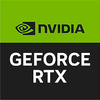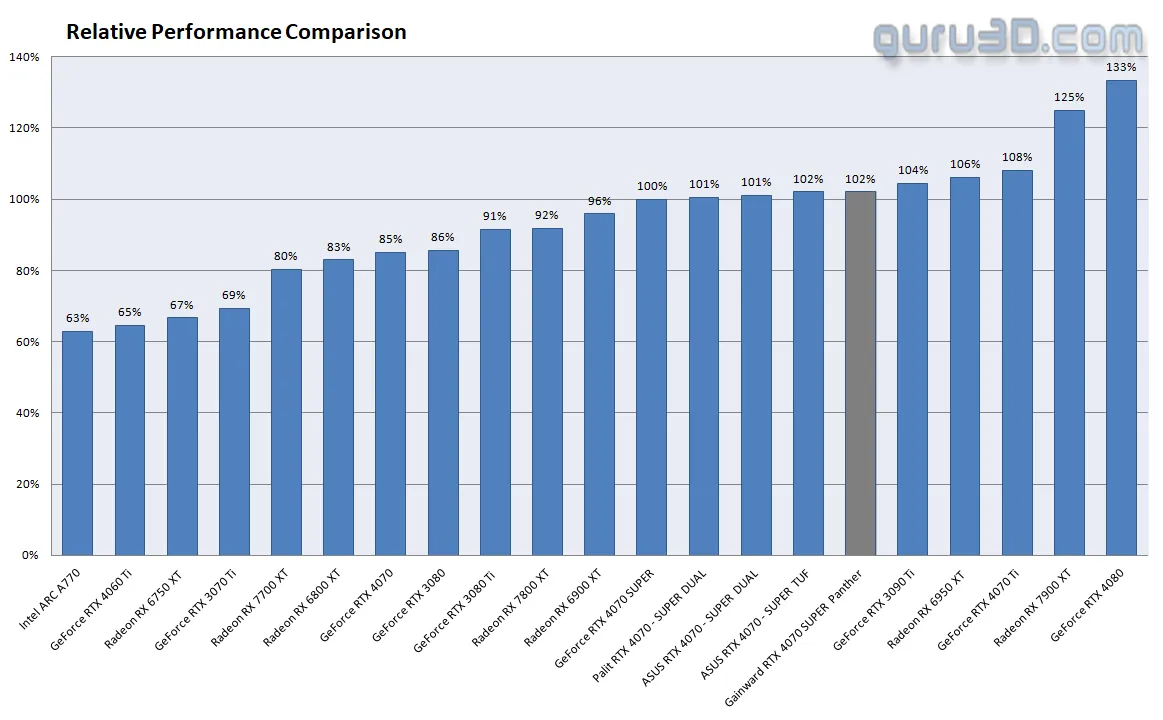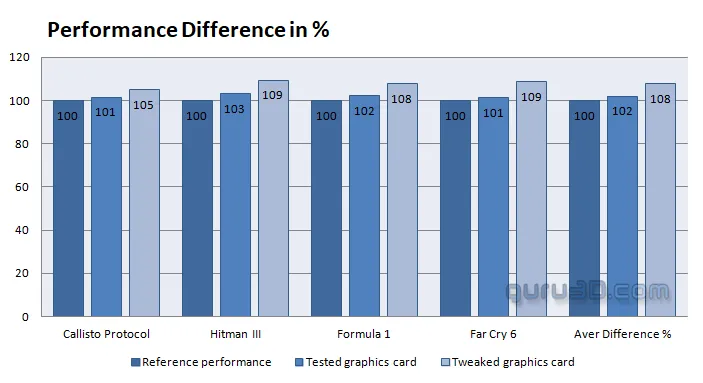Final words and conclusion
The Panther series graphics cards are designed with a triple-slot, triple-fan cooling system and a black shroud featuring aesthetically pleasing indents and patterns that are also functional. Their intelligent flow-through design aids in effective temperature regulation. These cards boast a sizable heatsink that is connected to a wide copper base, ensuring coverage for both the GPU and memory components. To prevent card sagging, a protective plate is included. While the Gainward Panther Edition may not significantly outperform the reference or founder models, its additional cost of $50 above the reference MSRP might be considered reasonable. The founder edition card remains a competitive option though. Nonetheless, users can easily enhance the Panther card's performance by approximately 5% with a simple manual adjustment. While subjective, the card's striking design adds to its appeal. Additionally, users have the potential to achieve an extra performance boost over the baseline Founder's Edition with simple tweaks. This graphics card is designed with features like ray tracing, DLSS3, and AI-powered assists, targeting gamers looking for optimal performance. It comes equipped with an increased count of 7168 shader cores (up from 5888), 12GB of 21Gbps GDDR6X memory on a 192-bit memory interface, and a maximum bandwidth of 504GB/s. Additionally, the RTX 4070 SUPER includes 56 RT cores, 224 Tensor cores, 224 TMUs, and 80 ROPs. It utilizes the same 35.8 billion transistor counting AD104 silicon as the RTX 4070 Ti, with 56 out of 60 streaming multiprocessors activated. This makes the RTX 4070 SUPER a compelling, more accessible option for those seeking high-end gaming performance. Boasting a powerful architecture, advanced ray tracing capabilities, and enhanced DLSS3 technology, the GeForce RTX 4070 SUPER showcases significant performance improvements compared to it 4070 predecessor. Compared to the Radeon Series the RTX 4070's ray tracing performance has a bit more stamina, making notable advancements in this field. Additionally, with the DLSS3 + Frame generation technology, the GPU can create remarkable visual experiences in games that support it.
Performance
The RTX 4070 SUPER is a graphics card that can create waves in the gaming world due to its rendering quality and gaming performance when combined with DLSS3 frame generation. The RTX 4070 provides a bit more value for the money. It is a well-balanced card that can handle gaming at WQHD and even 4K resolution, although it is targeted towards WQHD. Compared to AMD's offerings, the Nvidia GPU struggles to keep up with the Radeon RX 7900 XT, but has positive aspects like DLSS (3) and ray tracing features, which work exceptionally well, AMD cannot match Nvidia in this regard. The RTX 4070 SUPER is an excellent option for gamers who play at UWHD, QHD, and even UHD monitor resolutions.
The old rasterizer engine breaks right through the previous limit of extreme performance. The RTX 40 series now has the latest generation of Ray tracing and Tensor cores that are more powerful. So, do not let the specific RT and Tensor core counts fool you; it's all about how much performance one unit offers. Since they are close to the shader engine, they have become more efficient, which shows. Tensor cores are harder to measure, but from what we have seen, everything seems to be in good shape, as DLSS3 shows exciting values. Overall, the GeForce RTX 4070 SUPER makes sense at resolutions as low as 2K / 2560x1440, and sometimes up to 4K (3840x2160).
Cooling & noise levels
The graphics card, under full-load conditions, has a power consumption of just over 215 watts. This consumption is directly related to the heat generation of the GPU, which is located inside a sealed enclosure. In terms of noise, the card operates quietly, producing approximately 36-37 dBA. When subjected to stress, its temperature can rise to around 65°C, although this can vary depending on the airflow efficiency in the computer case. FLIR imaging does not indicate any thermal issues.
Energy consumption
In a previous chapter, we analyzed the GeForce RTX 4070 SUPER power usage during intensive gaming sessions. This graphics card typically requires about 225 watts of power (Total Board Power) to deliver its gaming performance. However, during actual gameplay, the power consumption tends to stabilize near 200-210 watts. This figure will vary slightly with customized models from various manufacturers, who might allow for a higher Total Graphics Power (TGP).
Coil whine
The presence of coil squeal in any GeForce RTX 4070 graphics card can vary, depending on the degree of the issue. It becomes audible when reaching high framerates, but typically remains at a manageable level. Within an enclosed case, this sound is likely to blend into the background noise. In our experience with this specific card, the coil squeal has been hardly noticeable
Pricing
The suggested retail price for the NVIDIA GeForce RTX 4070 SUPER, as set by the manufacturer, is $599 for the MSRP products. This price point is relatively high, especially when considering that the ideal cost for a graphics card should be lower than that of a current gaming console. Add-in Board (AIB) versions, which are more advanced, will be priced higher. It is expected that these models will cost an extra $50-100.
Tweaking
By adjusting the clock frequency and memory speed of your GPU, you can achieve a performance improvement. We have successfully increased the power limiter by 15%, allowing for enhanced performance within the card's existing power budget. This enhancement enables an increase in clock frequency, typically in the range of +150-200 MHz. As a result, the GPU boost clock frequency is expected to reach approximately 3050 MHz, though this may vary based on the dynamic frequencies in different gaming titles. Additionally, by adjusting the memory speed to 23 Gbps, a cumulative performance improvement of 9% can be expected in intensive GPU scenarios, in comparison to the standard reference performance.
Conclusion
The Gainward Panther Edition graphics card emerges as an appealing choice, especially if priced competitively. It features an efficient cooling system. However, it notably has a bit of factory overclocking and the ability to adjust power limits. Despite not having RGB lighting, this card impresses with its relatively low noise output, effective temperature management, and sleek black aesthetic. For video outputs, the card offers three DisplayPort connections and one HDMI port. Additionally, its backplate showcases a modern design. Additionally, it boasts an aesthetically pleasing backplate design. This card is suited for high-resolution gaming and demanding creative tasks, with its 12GB of VRAM being quite satisfactory for most applications. In the competitive landscape, particularly when comparing it to the Radeon RX 7900 XT specific capabilities such as ray tracing and DLSS3, areas are where the RTX 4070 SUPER shows notable strength. Conversely, the Radeon RX 7900 XT boasts a faster rasterizer engine and additional L3 cache, presenting it as a formidable alternative. However, with the RTX 4070 priced $150-200 lower, it may offer better value for some users. The RTX 4070 SUPER seems to align more closely in competition with the Radeon 6800/6900 XT/ 7800 XT rather than the 7900XT. Its performance can be likened to that of the RTX 3080series, varying according to the benchmarks used. Aesthetically, the Founder Edition models of the RTX 4070 SUPER are visually striking and add to its appeal with the new darker design. The card is capable of handling Ultra HD gaming, particularly when utilizing features like DLSS3 and Frame Generation, and even supports mild overclocking. This graphics card, priced comparably to NVIDIA's Founder Edition, stands out for users who prioritize a blend of performance and aesthetic design. It represents a solid baseline option in the 4070 SUPER series. This card is capable of handling even Ultra HD gaming with ease, especially when utilizing features like DLSS3 and Frame generation, and offers the possibility of a slight overclock. Despite the competition from NVIDIA's Founder Edition card, especially at its $599 price point, this card distinguishes itself with its quiet operation, refined design, and similar baseline performance, including tweakability options. We anticipate that the card's price will not exceed $649, though a $25 increase might be necessary due to its advanced cooling system. The Panther stands as a formidable option. Its performance is on par with the founder edition, which also offers low noise levels and an adjustable power limiter—a feature notably absent in the Panther. Despite this, the Panther excels as a WQHD graphics card, offering ray-tracing and DLSS3 support. Its moderate overclocking potential aligns with the expectations of a high-performance enthusiast's graphics card. The Panther's cooling and acoustic features set it apart, enhancing its design appeal. While its default performance boost is modest, at 2~3%, the card is particularly suited for users who value quiet operation and aesthetic appeal in their computer setup.
- Download NVIDIA GeForce drivers
- Sign up to receive a notification when we publish a new article.
- Or go back to Guru3D's front page
- Hilbert, LOAD"*",8,1.




